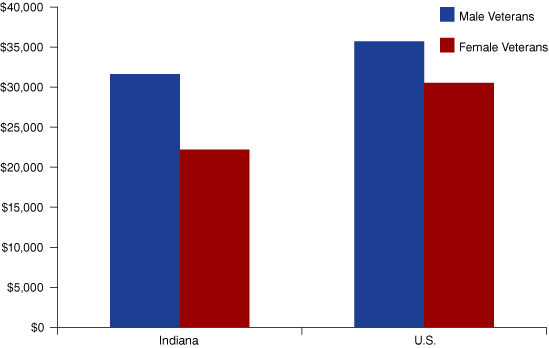Measuring Indiana: Veterans
The U.S. has been at war for more than 10 years now, first in Afghanistan and then Iraq. The media is filled with periodic stories of our soldiers coming home. Here we will focus on soldiers who have served in one of the branches of the U.S. armed services and upon discharge or retirement, become veterans. Indiana is home to about 2 percent of the nation's veterans, or 493,551 men and women. Most of Indiana's veterans served during the Vietnam era (34 percent), with 23 percent serving in Korea or World War II. Thirteen percent served during the period of August 1990 through August 2001, which included the Persian Gulf War. Six percent of our Hoosier veterans served during the Gulf War period which began in September 2001.
The vast majority of our veterans are male—95 percent compared to 5 percent female. Those percentages are very similar to the national averages of 93 percent and 7 percent, respectively.
Such similarities to national averages don't apply to the percent of veterans by race or Hispanic origin. For Indiana, the vast majority of veterans (91 percent) are white, compared to an 84 percent U.S. average; 8 percent of Indiana's vets are black or African-American (11 percent for the U.S.), and 2 percent in Indiana are Hispanic (compared to 5 percent nationwide).
Interestingly, veterans tend to have larger median incomes than non-veterans. In Indiana, the median income for veterans was $31,211 (U.S. was at $35,367). Indiana's female veterans, however, didn't do so well, coming in with a median of $22,207 compared to the national average for women vets of $30,540 (see Figure 1).
Figure 1: Median Income by Sex, 2010

Source: IBRC, using American Community Survey data
The poverty rate for veterans in both Indiana and nationally was 7 percent—well below that of the population overall. However, veterans experience unemployment at higher rates, with a 12 percent rate in Indiana for 2010 and 10 percent nationally.
Veterans tend to complete high school and go to college. Thirty-three percent of Indiana veterans have at least some college or an associate's degree and another 18 percent have at least a bachelor's degree. Like other Hoosiers, however, Indiana doesn't keep up with the national average of 26 percent of veterans with a bachelor's or higher.
Measuring Indiana is a series of articles we are writing to reveal data from the Census 2010 and the American Community Survey (ACS). The data on veterans is from the 2010 ACS and more information about this data set can be found on STATS Indiana: www.stats.indiana.edu/topic/acs.asp.
The IBRC at Indiana University's Kelley School of Business is the State Census Liaison, state partner in the Indiana Data Center Program, the State Representative in the Federal State Cooperative on Population, a member of the Bureau of Economic Analysis Working Group and a founding member of the national Association for University Business and Economic Research. The IBRC has been part of Indiana University since 1925, serving Hoosiers through research and data.
Carol O. Rogers
Deputy Director and Executive Editor, Indiana Business Research Center, Indiana University Kelley School of Business
